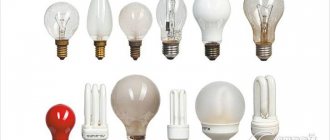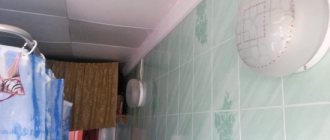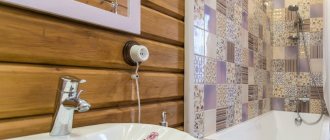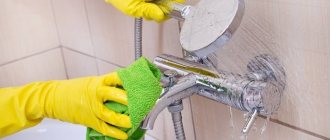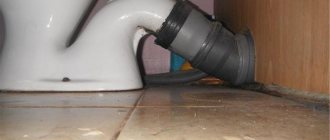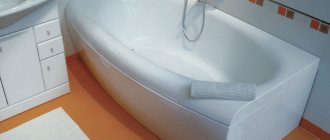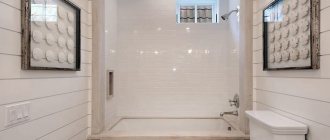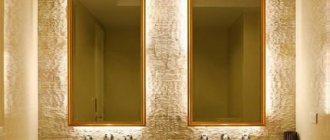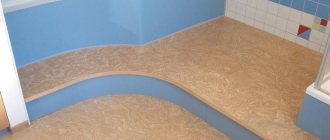Ruslan Konovalov
It is difficult to imagine modern life without devices such as sockets, which greatly facilitate the life of every person. And no one is surprised by the socket in the bathroom, necessary for a washing machine, hair dryer, and electric razor. It has a certain level of moisture protection and acts as an indicator of comfort. But at the same time, such an outlet will require proper installation and use.
Need for sockets
In old houses, bathrooms are not equipped with sockets. And sometimes it is inconvenient to use various household appliances. Modern bathrooms are large in size and equipped with various devices: showers, boilers, hydromassage, hairdryer, electric razor. They make life comfortable. Since using extension cords is inconvenient and unsafe, there was a need to install sockets.
It must be taken into account that in bathrooms there is often a need to connect a curling iron or install a washing machine. The latter is not recommended to be connected via an extension cord. Additional moisture-proof outlets may be needed for a dryer, underfloor heating system or illuminated mirrors.
Determining the type of bathroom devices
According to the rules, placing sockets in the bathroom is not prohibited, although due to the possibility of condensation and water droplets, there is a danger of electric shock. This also applies to toilets. Therefore, the issue of placement and installation of sockets must be approached competently and seriously. Regular sockets for wet or water-exposed areas are suitable, but only when located 2.5 meters from the water. Waterproof outlets are best.
Their choice is slightly varied; it is based on a classification based on two criteria - the number of connected devices and power. The last indicator is important; it determines which sockets and for which devices should be purchased.
For example, you need a socket for a washing machine with a power of at least 16 A, and for an electric razor 8 A is enough. They will definitely require grounding, and you need to choose devices that have an additional contact.
Regarding the design of sockets, everything is individual. Manufacturers produce a sufficient variety of moisture-proof devices that can fit into any interior. But the most important rule in choosing such devices is to pay attention to the labeling. It will allow you to decide which socket is suitable for a particular place in the bathroom. Housing protection is one of the main characteristics developed in accordance with international standards.
There is a standardized four-character code called IPXX. The first two symbols directly indicate the concept of protection itself, and the next two symbols indicate protection against the penetration of dust with particles and humidity with water.
For example, the IP 44 marking means that the socket is protected from foreign particles larger than 1 mm, as well as all-round splashes. And the IP 68 marking indicates that the socket can withstand complete immersion in water. The final choice depends on the areas in which the outlets need to be located.
Conclusions and useful video on the topic
A worthy example of the correct selection and installation of a waterproof double socket with correct connection to a separate circuit breaker:
The following video is presented solely as an introduction to advanced technologies in the field of electrical wiring components:
Finished products from popular manufacturing companies LEGRAND, SCHNEIDER ELECTRIC and BERKER have excellent characteristics of strength, reliability and safety.
It is also possible to purchase fittings from the Swedish ABB and the German GIRA, but these companies cost a little more due to the use of rather expensive materials in the production of products, including bronze and gold-plated metals.
We are waiting for your stories about choosing sockets for installation in bathrooms and swimming pools. Please write in the block located below, under the text of the article. Here, ask questions and comment on the material offered for review.
Dividing the bathroom into zones
The process of installing socket devices in bathrooms is regulated by relevant standards and regulations. According to them, sockets must meet the following requirements:
- have a hidden type of installation (inside a wall, protective housing);
- be equipped with a grounding contact;
- correspond to a degree of moisture protection of at least 4 (IP);
- have a connection to the power grid through an isolation transformer, RCD, differential circuit breaker.
According to regulations, devices should be distributed according to bathroom zones. There are four such zones in total:
- 0 - located in close proximity to water sources (baths, sinks, showers); in this area it is allowed to place equipment whose operating voltage does not exceed 12 V;
- 1 - located above the previous zone; installation of socket devices is possible if there are shower rooms with a cover that acts as a partition between zones 0 and 1;
- 2 - is a strip 0.6 m wide, originating from the boundaries of the two previous zones (outer edges); here it is allowed to install devices with moisture protection class 4 and higher for electric shavers, hair dryers and similar devices;
- 3 - starts from the outer boundaries of zone 2, ending after 2.4 m; here it is allowed to install sockets marked IP1.
Before installing sockets, it is imperative to distribute the room into zones, and then proceed to the actual installation.
Danger zones for electrical outlets in the bathroom and GOST rules
Danger zones in the bathroom and GOST rules
Some people mistakenly believe that sockets should not be installed in the bathroom at all. This may be partly true if the rules for the placement of faucets and the size of shower stalls are not followed. But in most cases, the standard size of this room allows you to place more than one outlet. The thing is that the bathroom is not uniform in terms of the degree of danger from electricity. It is divided into unique zones. For example, there is often water inside the bathroom sink, but almost never on the wall. Bathroom zones indicate the likelihood of water entering in a particular place, which can cause damage to the electrical system.
How to choose the best bathroom sink. Read about what you need to know when choosing here.
Zone 0 - the inside of the bathtub, washbasin or shower
Zone 0 - the inside of the bathtub, washbasin or shower
Any electrical appliances with a voltage of 220V are prohibited here. Only installation of waterproof devices with a maximum voltage of 12V is allowed.
Zone 1 is the area under the sink, above the bathtub, etc.
Zone 1 is the area under the sink, above the bathtub
It is allowed to install electrical devices with IPX5 protection here. Mostly water heaters are installed. When connecting, you must use three-core cable with a protective grounding conductor. Bathroom outlets are not permitted in this area.
Zone 2 - everything that is located 60cm or more from the first zone
There is also a zone prohibited for electrical outlets, but allowed for water heaters, hoods, and lamps that are turned on not from a switch, but from a cord.
Zone 3 - starts from where zone 2 ends
Example of a socket in a bathroom
Its width according to the old GOST is 2.4 m starting from the second zone. The new edition does not regulate and considers all the space beyond zone No. 2. It is in this area that the installation of sockets in the bathroom is allowed. Otherwise, if there is no third zone, it is prohibited to install a plug socket inside. It is allowed to mount only on an external wall, and even then at a distance of 60cm from the door.
In the Code of Rules SP 31-110-2003 , this is stated as follows:
14.40 In apartment bathrooms, washrooms, showers, bathrooms and pre-shower rooms in hostels and hotels, it is allowed to install plugs in zone 3 in accordance with GOST R 50571.11, connected to the network through a separating transformer or protected RCD for a current of up to 30 mA.
So, the electrical outlet in the bathroom should :
- be no closer than 60 cm from the edge of the bathtub, shower stall or washbasin (in zone 3);
- join via RCD
In GOST, in addition to determining the size of bathroom zones, there are additional requirements for the degree of protection.
701.512.2. Electrical equipment must have at least the following degrees of protection:
in zone 0 - IPX7;
in zone 1 - IPX5;
and in zone 2 - IPX4 (IPX5 - in public baths);
in zone 3 - IPX1 (IPX5 - in public baths).
Where instead of X, the degree of protection is replaced by the number that is suitable for a given zone, for example, for zone 1 equipment with protection IP55 is suitable, for zone 2 - IP44, then by analogy.
Choosing locations
The guideline in choosing the location of sockets should be the division into zones and a number of additional parameters (PUE). It should be taken into account that the correct location of devices in bathrooms is 60 cm from the source of moisture. The optimal level corresponds to the average between the suitable zone and ease of use.
Therefore, the socket for the washing machine is installed at a height of 40 or 50 cm from the floor. It must be taken into account that dampness and temperature create conditions for the formation of condensation on the walls. This also applies to walls adjacent to staircase landings. Therefore, socket outlets should be installed at a height of at least 1.3 m from the floor surface.
And the height of the socket for the shower stall should not exceed its cover (2 m). The possibility of flooding should also be considered, so do not place sockets low to the floor. When installing sockets in old houses, preference should be given to semi-hermetic devices marked IP 44, installing them far from the water source.
Where should electrical outlets be in the bathroom?
As a rule, they are placed at a height of no lower than 25 cm from the floor. Height does not have a specific digital regulation, so a simple principle works here - the higher, the better. The main thing here is to make sure that the wire is long enough. The average acceptable distance from the floor and faucets is selected - 60 cm. Under no circumstances should water reach the level of electrical equipment. Electrical sockets and switches must be special - with a degree of protection not lower than IP44.
Scheme
For heated towel rail
If you have an electric heated towel rail, it is better to make an electrical outlet for it next to it, rather than under it. Otherwise, water from wet clothes will flow towards the outlet.
For washing machine
For ease of operation of the washing machine, the socket for it is located at a height of 100 cm from the floor. There are times when it needs to be hidden, for example, when there are small children in the family. Then it simply hides behind the washing machine to a height of at least 60 cm. The socket must be special - with a degree of protection of at least IP44.
Cable outlet for water heater
First you need to choose which water heater will be in your bathroom. And only then they draw a cable outlet for the water heater, when its size and the method of connecting the water are already known - from below or from behind.
Additional sockets in the bathroom
To install an outlet in a cabinet (most often in the bathroom there are mirrored cabinets), you need to decide on the choice of this very cabinet. After which it will be clear where it is better to install it.
For beauty and maintaining style, you can play with the color palette. For example: a blue switch for the bathroom, any suitable color to match the color of the living room walls, or a metal socket for the corridor. And so on, you already independently focus on your color scheme. How deliberately it will look on the walls will depend on the correct selection of the electrical outlet for the interior.
Bathroom interior
Electrical safety rules
Having considered the rules for zoning the bathroom and choosing the optimal locations, you should move on to the installation rules regarding electrical safety.
- Performing grounding. It is a factor that is responsible for safety and is provided even in old-style houses. Grounding cannot be routed into the bathroom, metal pipelines, or building fittings. It needs to be brought to the entrance panel, where the circuit breakers for instant de-energization of the apartment are located, or to the distribution box.
- Automatic machines. Such switches should be installed when the power of the equipment connected to the sockets is sufficiently large. This situation occurs when a washing machine is installed indoors. If one electric razor operates, it can be connected to a general power supply.
- RCD. Such protection should not be abandoned. It is useful to install a device with a protective shutdown in the bathroom on all wiring. In this case, the RCD will react to the slightest leakage currents and turn off the power supply completely.
It should also be noted that in bathrooms no terminal strips with twists or other wire connectors are needed (even under tiles). An exception is terminals for lamps. Communication of the premises must be carried out outside the premises. When installing distribution wiring, do it on the other side of the wall.
General safety rules
It is clear that for the safe use of household appliances and auxiliary equipment, you need to follow trivial safety rules when connecting or disconnecting an electrical appliance to an outlet.
For example, before plugging the plug into the socket, inspect the cavity of the socket connector and make sure that there are no foreign objects in the socket, and that there are no fumes or “dark” spots on the surface of the socket and near it on the surface of the wall where it is installed.
If obvious signs of “burning” are visible on the surface, you must immediately stop any attempts to connect the electrical device to the network and turn off the packager. Then replace the socket
Next, inspect the wire of the electrical appliance and the plug, check for the absence of exposed parts of the wire and darkening on the cable. If the above factors are detected, stop using this electrical appliance and call a specialist. Or check the fault yourself if you have the appropriate skills.
When disconnecting the plug from the socket, it is recommended to hold the surface of the outer panel of the socket with your free hand and smoothly pull the plug out of the socket. If you sharply “pull” the plug from the socket, you can “rip” the terminal block from the socket.
Do not try to put the socket back in place under any circumstances. First you need to turn off the electrical network at the distribution panel, then turn off the device, remove the external panel of the socket and only then return the terminal block to the socket of the socket
Everyone knows that water is an excellent substance for transmitting electrical charge, therefore it is necessary to avoid any contact of moisture with the conductive element of the network, which is the socket. Although the outlet itself is protected from moisture, this does not mean that electricity cannot affect human health.
If you find water near the outlet, we strongly recommend that you completely turn off the power supply in the entire room, for example, at the distribution brush, and call a specialist.
Selecting wires
Connect moisture-resistant electrical outlets using a three-conductor, double-insulated cable. Each conductor of such a cable has its own marking in the form of a different color shade, which facilitates the installation process. According to the rules, the phase wire is painted brown, the ground wire is yellow-green, and the neutral wire is blue or blue.
It is worth connecting sockets indoors using copper cables that:
- less susceptible to oxidation;
- are flexible, allowing you to easily connect the cable to the corresponding contacts;
- have the ability to withstand significant loads;
- have a small contact resistance when connected to sockets and automatic machines.
Copper cable strands can consist of a whole bunch of twisted cables or one thick wire. There are no big differences between them, but the thick wire is less flexible, so it will be somewhat difficult to connect the outlet close to the floor. And twisted wires when connected to an electrical outlet will require coating with solder. You should also pay attention to the diameter of the wire, which will directly depend on the number of devices connected to the outlet.
Carrying out wiring installation
The installation of electrical wiring is carried out at the rough finishing stage and can be done in two ways:
Grooving
Used for installing hidden wiring, allowing you to hide it in the wall. First you need to determine and mark the route on the walls of the bathroom where the cables are supposed to be laid. They should be placed vertically along a plumb line or under the ceiling, horizontally. Additionally, you should note the installation locations of sockets.
Then you need to move on to the direct gating procedure. It can be carried out using a strober or a hammer drill with a special nozzle. For large volumes, a disk cutting tool (grinder with a segmented diamond blade) is suitable. Then attach the cables using an aluminum mounting strip or perforated strip. In their absence, alabaster is also perfect. You can also use a dowel clamp. Next, all that remains is to seal the channel with the laid cables.
Installation in plasterboard
Partitions made of plasterboard have not lost popularity to this day, because they are of high quality, convenient and fast. And it’s also convenient to lay wiring under it. The main thing is to avoid “meetings” with self-tapping screws or screws that secure drywall. Usually, wiring laid 20 cm from the floor helps with this.
But for reliability, the cables should be installed in a corrugated pipe that has the appropriate fire safety certificate. This must be done before sheathing the second side of the partition. It should be pulled through the holes located in the vertical posts of the frame. If the corrugated pipe runs close to the screw, you should move it or bite off the screw. Next, you should fill the voids of the partition with sound insulation and sheathe the other side so that the cables are tightly clamped between the partitions.
If the above methods are not suitable, there is another option - installing electrical wiring in a box. Modern boxes are made of durable plastic, which is characterized by its inability to catch fire. The box consists of two parts: one needs to be attached to the wall using simple nails or screws. The second part easily snaps onto the finished base, only before doing this you need to stretch the wire through it. This installation option allows for additional safety from damage and fire.
Installing wires through a box is a very simple task. It is enough to make markings in accordance with the project, cut the necessary sections of the box and install it along with the wiring. Another advantage of using the box is the ability to open it at any time and replace the wires if necessary. The aesthetic side of the issue also plays an important role. Experienced manufacturers produce boxes of various colors and imitations for cornices or baseboards, so they do not spoil the interior at all.
Step-by-step instructions for installing sockets yourself
Installation of an electric point is carried out in several stages.
Preparation of tools and materials
The amount of materials used and types of tools depend on the scope of work. If you plan to replace the wiring, you will need the following items:
- perforator;
- drill with core bits;
- indicator screwdriver for determining voltage;
- building level;
- a set of screwdrivers with different attachments;
- copper cables;
- automatic switches;
- cable cutters;
- distribution boxes;
- protective sleeves.
Cable cutters.
When replacing an outlet in a new home, all you need is a pair of wire cutters, a screwdriver, and electrical tape.
It is necessary to prepare personal protective equipment (insulated work gloves, mask, goggles).
Chasing walls for wiring
Grilling is the most difficult stage of installation work. To prevent the appearance of dust and dirt, the wall chaser is combined with a vacuum cleaner. There are combined devices that cut out 2 channels at once. They move easily and quickly absorb dust. In the absence of professional equipment, you can use the following tools:
- grinder with diamond discs;
- perforator;
- chisel and hammer.
The groove is completed by forming a hole for the socket box. To do this, the drill is replaced with a crown attachment. After this, you need to clean the room - construction debris can make it difficult to install the outlet.
Installation of a socket box
The socket box is installed before laying the tiles. When replacing a device, you need to remove the old housing and unscrew the screws. After this, remove the socket box and install a new one. If installation starts from scratch, perform the following steps:
- Trying on a new socket box. If the hole is not of sufficient size, it is widened with a chisel.
- Prepare the niche by clearing it of dust and dirt. The bottom and walls of the hole are treated with putty.
- Insert the socket box into the niche. Remove excess solution. Installation of the socket begins only after 24 hours. This will allow the solution to harden and secure the socket box.
Installation of socket boxes in a plasterboard wall.
Installation and connection of the socket
Installation of the electrical point is performed as follows:
- De-energize the wiring by turning off the protective device in the panel. Clean the ends of the cables from the braid using a knife, wire cutters or pliers.
- Remove the decorative cover of the socket, unscrew the screws, and look for the necessary contacts. When connecting, take into account the colors of the wire insulation. White indicates phase, blue indicates zero, and green indicates grounding.
- After connecting to the terminals, the wires are left inside the box. Do not bend or squeeze. The structure is installed in the socket box and secured with screws.
- Close the socket housing. The installation is completed with a test. After applying current, measure the voltage with a multimeter.
Installing a moisture-resistant overlay is easier. The installation of the socket box is not carried out. After gating, they begin to connect the wires.
Installing sockets
Before installing sockets in the bathroom, you should decide how many there will be. It is necessary to provide each consumer with a power source. It is possible to install double or triple sockets. This is more convenient than installing several single ones. Next you need to move on to installation, which can be done in several ways.
- Overhead installation type. Involves the installation of external-type moisture-proof sockets with a protruding plastic casing. Often used when laying cables in plastic boxes. It is performed using self-tapping screws that fix the device to a partition or concrete (brick) wall.
- Hidden installation type. It is used when laying cables in drywall or fines. If you intend to mount it in drywall, you should make a hole in it the same size as the box for the socket. Then you need to press it to the drywall using special screws, and then connect the wires. Next you need to attach the socket to the box. When installing the device in the wall, you first need to make a ring groove corresponding in size to the socket box. After this, a hole is cut out with a hammer drill or chisel and the box is secured in it. Further installation does not differ from the previous option.
- Mounting inside a protective casing. According to safety requirements, sockets with a moisture protection class of at least IP4 should be installed in the bathroom. But if necessary, this requirement can be circumvented. The location of the device inside the electrical panel housing with water protection class IP4 will help with this. This design should be used in two cases:
- it is not possible to purchase waterproof sockets;
- there is a need to install a built-in lighting switch or a heated floor control unit inside the panel.
- First you need to fasten the shield to the wall using dowels and nails, then insert the end of the cable inside and connect it to the terminal block using the appropriate terminals. Mounting brackets will help secure the socket in the panel body.
Waterproof sockets are devices that are difficult to live without in modern life. They allow you to easily use a washing machine, heat water using a boiler, or dry your hair with a hairdryer. Such sockets are very diverse and require certain placement conditions. If you follow the necessary safety measures, using moisture-proof sockets will be a pleasure.
Sockets for outdoor use
If you are the owner of a private house, a country estate or an ordinary 6 acres with a trailer, then there is no need to talk about the variety of situations when you need a simple outlet “at hand”. In order to avoid purchasing 100-meter extension cords, it is rational to install the required number of sockets on the outside of any object.
Waterproof socket blocks can be installed almost anywhere: the wall of a building, on a wooden support for a gazebo, on the “deck” of a mini-pool, inside a stone/brick fence support, on the outside of a wall in a garage or other utility room.
Innovative technologies are penetrating everywhere, even such public places as parks, squares, and embankments are not lagging behind in this regard. Now there is no need to run home to charge your favorite device
These sockets can easily be used to connect virtually any electric tool or special equipment, which is more economical in terms of energy consumption compared to devices powered by gasoline and diesel engines.
For example, we plug into an outlet an electric saw, electric pruning shears, an electric barbecue and oven, a submersible pump and a pressure water/air compressor. Let's move on to passive relaxation - we can easily connect an external audio system, a television panel and much more to such sockets.
Regardless of the purpose of using the “street” outlet, we recommend adhering to some notes on the choice of location and method of mounting the electrical connector:
- It is advisable to install the socket under any ledge or visor;
- height from the ground surface at least 75-80 cm (taking into account the possible level of snow cover);
- the cable for the socket must be with protective grounding;
- connecting the wire to the socket exclusively from below - this will prevent flowing water from getting inside the electrical equipment.
Protective membranes must be provided inside the socket, and the contact group must be made of bronze or some copper alloy. Such an “outdoor” moisture-resistant outlet is integrated into an individual package - this will protect the rest of the power supply network in the event of a malfunction.
